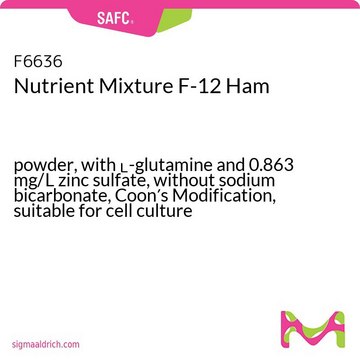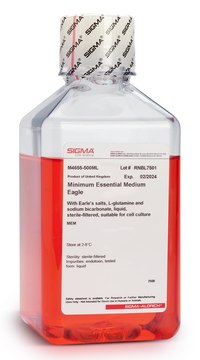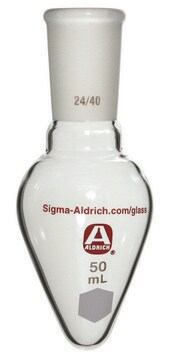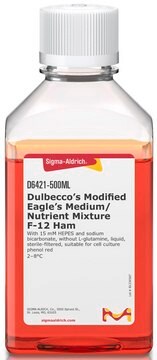N3520
Nutrient Mixture F-12 Ham
Kaighn′s Modification, with L-glutamine, without sodium bicarbonate, powder, suitable for cell culture
Synonyme(s) :
Ham’s F-12
Se connecterpour consulter vos tarifs contractuels et ceux de votre entreprise/organisme
About This Item
Produits recommandés
Forme
powder
Technique(s)
cell culture | mammalian: suitable
Composants
NaHCO3: no
sodium pyruvate: 0.22 g/L
HEPES: no
L-glutamine: yes
phenol red: yes
Conditions d'expédition
ambient
Température de stockage
2-8°C
Vous recherchez des produits similaires ? Visite Guide de comparaison des produits
Description générale
The nutrient mixture Ham′s F-12 is developed by Ham and it has higher levels of amino acids, vitamins and trace elements. Putrescine and linoleic acid are added to the formulation. Nutrient medium was originally designed for the serum-free growth of Chinese hamster ovary and lung cells. When used with whole or dialyzed serum or in combination with hormones and transferrin, it is widely used to grow mammalian and hybridoma cells.
Application
Nutrient Mixture F-12 Ham is used for the following applications:
Kaighn′s modification of Ham′s F-12 and Coon′s F-12 has increased concentrations of amino acids and pyruvate, as well as modified salts (Konigsbergs). This medium was designed to support the growth of differentiated rat and chicken cells, and primary human liver cells.
- HeLa (human cervix adenocarcinoma cells) were grown in this medium (nutrient mixture F-12 Ham) supplemented with 10% heat-inactivated fetal calf serum
- Used in cell culture for different cells during maintenance and incubation (i.e. A549 cell line was maintained as a monolayer in nutrient mixture F-12 HAM Medium along with other components)
- Used in media for the propagation of Cowdria ruminantium
- Used during preparation of primary mixed glial cultures
Kaighn′s modification of Ham′s F-12 and Coon′s F-12 has increased concentrations of amino acids and pyruvate, as well as modified salts (Konigsbergs). This medium was designed to support the growth of differentiated rat and chicken cells, and primary human liver cells.
Quantité
Formulated to contain 11.1 grams of powder per liter of medium.
Reconstitution
Supplement with 2.5 g/L sodium bicarbonate.
Souvent commandé avec ce produit
Réf. du produit
Description
Tarif
Mention d'avertissement
Warning
Mentions de danger
Conseils de prudence
Classification des risques
Skin Sens. 1
Code de la classe de stockage
11 - Combustible Solids
Classe de danger pour l'eau (WGK)
WGK 3
Point d'éclair (°F)
Not applicable
Point d'éclair (°C)
Not applicable
Faites votre choix parmi les versions les plus récentes :
Déjà en possession de ce produit ?
Retrouvez la documentation relative aux produits que vous avez récemment achetés dans la Bibliothèque de documents.
Les clients ont également consulté
Hong Yang et al.
Environmental science and pollution research international, 25(1), 867-876 (2017-10-27)
This research is designed to investigate the regulatory effect of miR-18a to the target gene connective tissue growth factor (CTGF, or CCN2), by participating in TGF-β1 signaling pathway and explore the pathogenic mechanism of miR-18a in pulmonary injury induced by
A Tansu Koparal et al.
Cytotechnology, 43(1-3), 149-154 (2008-11-13)
Carvacrol, the predominant monoterpene in many essential oils of Labitae including Origanum, Satureja, Thymbra, Thymus, and Corydothymus has substantial antibacterial, antifungal, antihelmintic, insecticial, analgesic and antioxidant activities. Approximately 75% of lung cancer is non-small cell carcinoma (NSCLC) which comprises several
Anna Mero et al.
Journal of controlled release : official journal of the Controlled Release Society, 125(2), 87-95 (2007-11-23)
Poly(2-ethyl-2-oxazoline) (POZ) was synthesized by living cationic ring-opening polymerization under microwave irradiation yielding polymers with low polydispersity indices (PDI, 1.15). The polymerization was quenched with sodium carbonate yielding a hydroxyl end-group with a high degree of functionality. The hydroxyl group
E Zweygarth et al.
The Onderstepoort journal of veterinary research, 68(1), 37-40 (2001-06-14)
Chemically defined media, termed SFMC-23 and SFMC-36, were devised for the in vitro culture of Cowdria ruminantium, the causative agent of heartwater in domestic ruminants. Both media were based on Dulbecco's modified Eagle's medium nutrient mixture Ham F-12 (DME/F-12) containing
Jose A P Diniz et al.
The American journal of tropical medicine and hygiene, 75(4), 691-696 (2006-10-14)
Primary cultures of embryonic murine neurons and newborn mouse astrocytes were inoculated with West Nile virus (WNV) strain NY385-99 to compare the pathogenesis of WNV infection in these types of CNS cells. Two different outcomes were observed. WNV infection in
Notre équipe de scientifiques dispose d'une expérience dans tous les secteurs de la recherche, notamment en sciences de la vie, science des matériaux, synthèse chimique, chromatographie, analyse et dans de nombreux autres domaines..
Contacter notre Service technique








